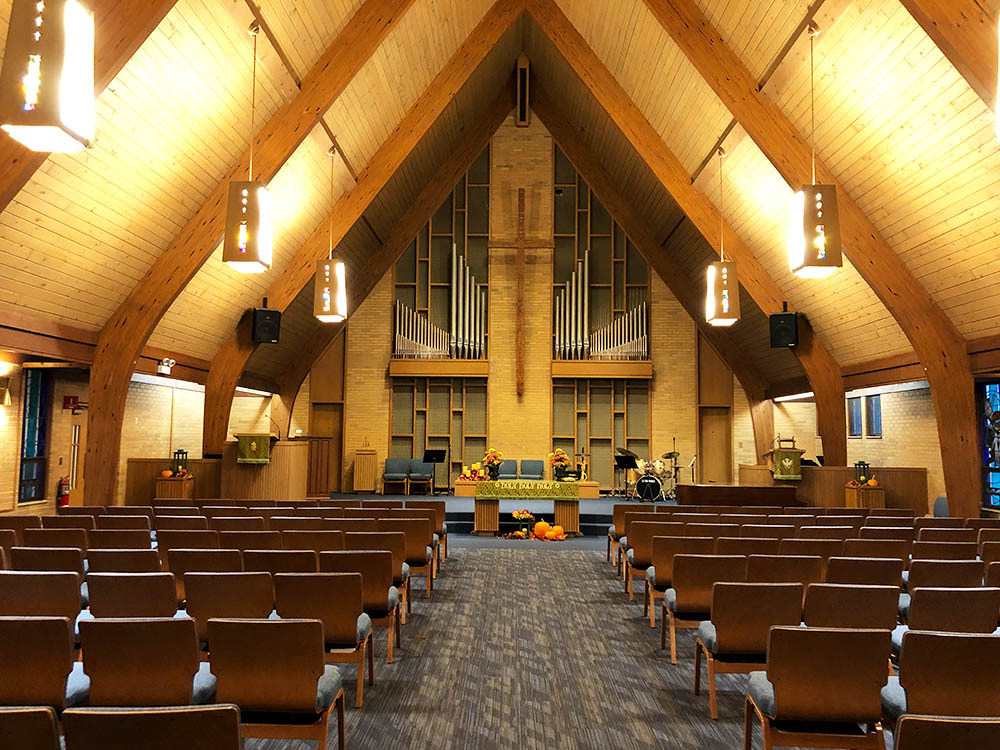March 12, 2020 is a day seared into my memory. I was in New York City, excited to attend a Broadway show with my wife. Instead, two hours before the performance, a text informed me that Broadway was closing. There would be no shows. No dinners. No cheerful crowds. Covid-19 had arrived.
Between March and April 2020, as the number of new cases kept growing, the world became a scary and confusing place. Suddenly we were in lockdown and streets were empty. The virus paralyzed major cities and towns and it was as if time itself stood still. Dramatic shortages surfaced. There were not enough surgical masks, gloves, antiseptics, and ventilators. Even the so-called experts did not have straightforward answers.
For Partners for Sacred Places, there was another aspect to consider: what about congregations that had begun capital campaign projects before the pandemic or those just about to launch a campaign? Capital campaigns are organized, planned efforts to raise substantial sums of money in a relatively short period to make capital improvements, fund new ministries, or perhaps create an endowment – and are never easy in the best of circumstances.
A capital campaign is far more than asking for money – it’s a sacrificial effort realized by an entire community. For a major capital project to be successful, especially with older buildings, solid planning, organization and, above all, a strategy that will fit the mold of that particular congregation and community are required.
What would a capital campaign look like in the midst of Covid? Was it even realistic to contemplate one? As congregations scrambled to learn how to conduct virtual worship, suddenly their focus on capital campaigns shifted to the back burner.
Fortunately, we began to discover that technology can be our ally and many of the “details” of a capital campaign could be successfully completed remotely. We learned that many of the fundamental elements of a capital campaign — such as the case statement, donor identification, the pyramid of gifts and the feasibility study – can be executed from a distance, often hundreds of miles away from our clients. Meetings, conversations, and even training could happen via Zoom. Congregations found their rhythm for conducting worship virtually, bringing spiritual sustenance to their members and friends, and beyond. Even former members who had moved away could now attend worship again. In churches, synagogues and temples, volunteers and clergy quickly became familiar with technology including people well into their retirements.
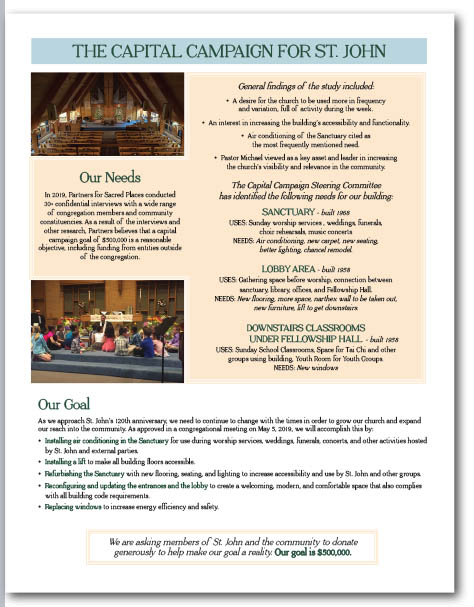
A page from the case statement of St. John United Church of Christ. Courtesy of St. John UCC
Despite the trials and pain of the last two years, many congregations have demonstrated their ability to pivot quickly, learn and try new approaches. St. John United Church of Christ in Arlington Heights, Illinois, for example, planned its Vision 20/20 (Building a Vibrant Community Campaign) as the congregation was approaching its 120th anniversary. St. John was open to changing and adapting in the midst of the pandemic, to “grow our Church and expand our reach into the community.”
St. John’s pastor, Michael Jones, says: “Launching and running the Campaign for St. John virtually was not what we originally had planned. Still, our leadership found that with the support and guidance of Partners for Sacred Places, combined with an honest assessment of where our congregation was financially, was exactly what we needed to move forward despite many unknowns. We found our donors were just as willing or even more willing to support the Capital Campaign during the pandemic. Regular giving stayed steady throughout, which led us to believe that the Capital Campaign would still be successful. The virtual approach, which we were already adapting to in all other areas of church life, brought comfort to donors concerned about safety, etc. We ran an almost 100% virtual campaign, and our congregation and donor’s generosity exceeded expectations!”
Congregations may have had worries about the economy and its impact on a campaign. How can a congregation run a capital campaign and raise hundreds of thousands of dollars (or millions!) if the economy is fragile and people are losing their jobs? Fortunately, government stepped in to help many businesses, and many white collar workers retained their jobs and their ability to support a campaign. The stock market continued to do well, and many investments did not suffer substantially.
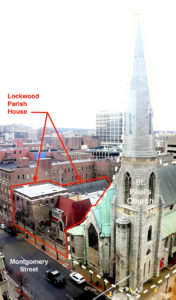
Illustration from St. Paul’s case statement, showing Lockwood Parish House in relation to the church. Elizabeth L. Crawford, Crawford & Stearns / Architects & Preservation Planners, PLLC
Overall, according to new data from the US Giving Institute (Giving USA Foundation), Americans have been more generous than ever. In 2020 Americans gave over $471 billion to charity, a 5.1% percent increase over 2019.
Giving by individuals represents 69% of the total, or a staggering $324 billion, representing an increase of 2.2 percent from the previous year. Giving by foundations has grown by about 17 percent since the previous year, up to a total to $88 billion.
Americans are generous and I want to believe that the human spirit is as well. Our clients and their congregations have shown that same spirit to us.
St. Paul’s Episcopal Church in Syracuse is stunning, built in 1884 of Onondaga limestone in Gothic Revival style. It stands tall and elegant, with a spire that soars over 200 feet into the sky on the corner of Montgomery and Fayette Street. It’s a lively parish that deeply cares for its community, a parish that we learned was ready to go the extra mile to help and witness the gospel across the city and region.
Partners for Sacred Places had been working with St. Paul’s for several years on different projects, and in 2020 was retained to serve as the church’s capital campaign consultants. As the Rector, The Rev. Philip Major stated, “We were surprised and heartened by the strong response of our congregation to a capital campaign conducted almost entirely through video conferencing. I would not have believed it possible for members, even those in their nineties, to meet us and make very generous pledges of support. My personal experience was that our conversations with members were powerful, even spiritually uplifting, for everyone involved. We learned that many components of Partners’ method were enhanced and made more effective by adjustments required by the pandemic. This was especially true for the task force structure: these meetings were more efficient, and it was easier to include a cross-section of our members because of video-conferencing.”
The Capital Campaign of St. Paul’s was an ambitious one, seeking to raise $1.7 million to restore and bring new life to the Parish House. The church’s “Open Doors” Campaign will allow the congregation to rehabilitate the historic 1909 Parish House and preserve the 1883 Hadley Chapel. The church was successful….and ran the entire campaign virtually!
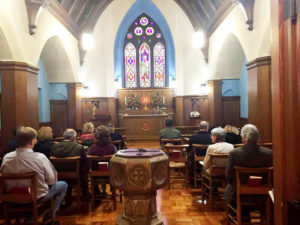
The 1883 Hadley Chapel of St. Paul’s, included in resotration effort. Courtesy of St. Paul’s Episopal Church
Other active clients, such as Touro Synagogue in New Orleans, St. Michael’s Episcopal Church in New York City, Luther Memorial Church in Des Moines, St. Mary and the Archangel Michael Coptic Orthodox Church in Nashua, New Hampshire and many others are working on their campaigns and will be successful even amidst the gravest crisis of our time.
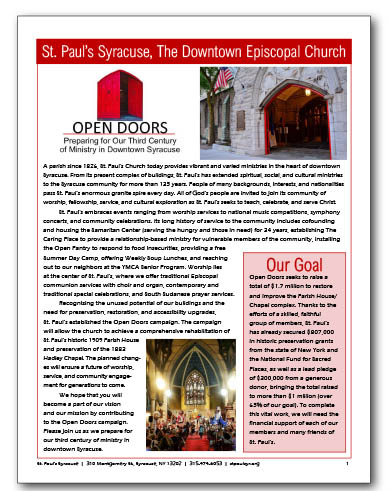
A page from St. Paul’s case statement. Courtesy of St. Paul’s Episopal Church
We have learned that it is possible to conduct a capital campaign with the support of technology and ingenuity. You need not be afraid! Being organized and patient are essential because everything is more complex and takes more time.
Now may be the moment for you to run a capital campaign. Your need is still there, and you need to act. Remember that donors don’t go away but give more during national and world crises, like 9/11 or the recession of 2008-09. The resources to support you are out there…and you have a new and powerful story to tell. Go tell it!

